Much scope by Guanche caves for intrigung cavemen explorations.
Look at the Guanche caves depicted beside. Most of them served as customary dwellings of their people's lower class and were open to one side. Those cavemen who were also called the Guan Chinech, originally, were the natives of Tenerife island called Chinech, Chenech or Achinech.
It was found already by early Portuguese explorers and missionaries. Records exists from 1336 until 1341. Earlier stop overs could not be confirmed.
Go to La Coruna above Icod el Alto. There, encounter the look-out by the paraglider piste of Los Realejos. Direct your gaze at the mountains opposite with a good camera lens. Zoom in for an even better picture of this awesome, breath taking cave geography and geology of amazing, unique Tenerife Tinerfe of wayback.
Just now, find information on how to get to la Coruna from a country village by the Camino Real Kings Highway of Icod el Alto.
Discover steep mountainous cliffs, riddled with caves of all sizes. However, shelters made with piled up rocks and stones which were covered with reeds, rush and grasses, also existed in more remote spots.
Cuevas de Chinamada village
By the way, some incredible cluster of 30 caves which have been incorporated into a modern housing hamlet are still inhabited in the Anaga Mountains since the days of the Guanches. The location with cave restaurant is known as Las Cuevas de Chinamada and can be reached from Punta de Hidalgo.
There, most mountain paths are too small to merit the expression mountain roads. Indeed there is no road in the vicinity of the caves. That's why the wheel was never missed for altitude living by mountain path ways in pre-Spanish Tenerife. All trails below and around Spain's highest peak Teide were of natural origin, as most were created by typical goats which love heights. .
The goats supplied their hides for clothing. Their horns were even used for weapons. Berries, stones and shells served for bead jewelry. Needles made of fish bone or horn were also used for sewing the Tamarco capes of Guanches. Their wool came from indigenous sheep. You may note many depicted stone men neolithic tools, some of which resembled astounding knives made of sharp, glass like, volcanic silica also known as silicon dioxyde. Those mountain sheep, by the way, are as good as extinct in Tenerife.
Survival of the Tenerife aborigins after 1498
When I came to Tenerife in 1997, I was told that some aborigines of stone age times were still living in caves in South Tenerife remote mountain areas. I didn't believe it, really. However, the academic personality Carmen Nieves Luis Garcia of the Folkore Museum Museo Los Alzados located a genuine family of Guanches at Icod el Alto. This family called Los Alzados was still associated with nearby caves by some locals. Unfortunately, most of the stone cavities were bulldozed during road construction, not long ago.
By the way, the mural beside depicts a Tenerife cave dweller in a peaceful and picturesque setting with its pets, its cave and some daily gadgets spread out on the floor.
Neolithic people cavemen culture Tenerife
Huge semi hollow rocks, most of which were extremely hard to access, served a rather small fraction of Neolithic dwellers of Tenerife as hide-outs until the early XX from as early as 1498. Many of them were in Tenerife South or anywhere on hard to reach slopes. However, generally, they were abandoned when tourism development started by 1970. Others were destroyed by the building of the TF1 and TF5 freeways. That was the end of the Tenerife cavemen culture which is said to go back more than 2000 years.
Juan Bethencourt Alfonso and Álvarez Rixo's finds on Guanche cave culture
So called Pegan aborigines continued living in caves. They kept on being very much part of Nomadic Tenerife heritage after Adelantado de Lugo's conquest of the biggest of all Canary Islands. The cave occupation by the neolithic tribes of the island was still confirmed by early Cabildo documents. Much later, the Tenerife celebrity Juan Bethencourt Alfonso wrote this down as well, before he passed away in the early XX century. Very slowly, more and more cavemen of the Guanches assimilated with the rest of the Spanish population and formed a new resident gene pool. By the way, Africans which were brought in as slaves kept to themselves, generally. The historical mayor Álvarez Rixo of Puerto de la Cruz who was also an amateur archeologists had the Royal caves of the last Guanche king Mencey of Taoro excavated. Artefacts are to be found at Puerto's archeological museum as well as in Santa Cruz.
Many traditions of Tenerife's precolonization, such as Aborigine goat culture and the Gofio grinding stones live on. Generally now, they are partly mechanized, such as a privately owned museum peace of a grinder of grains of Icod el Alto. Gofio, meat and milk of goats as well as sheep made up the Tenerife cave dwellers' main diet.
Uncomplicated living due to a mild climate.
They needed little clothing because of the fortunate Tenerife climate. Today, their Tamarcos which resembled capes can still be seen in folklore. However, you will encounter them sleeveless or with the long sleeves of aristocratic Guanches. By the way, the original Tamarco was made of goat or sheep hides, only. Little satchels, as displayed at the ethnic museum of Santa Cruz next to the TEA art center, were also made of the same leather. The rest of their minimalistic, nomadic dress code was not allowed after the last nine Aborigine tribal leaders which were called Menceys made Spain history in Los Realejos. From then on, mummification was also frowned upon. Name changes of the inhabitants of the neolithic Chenech peoples legitimized cults and habits into Spanish customs. Catholic baptism sealed the lot. Tenerife's 'Romerias' date back to the same cavemen era. Religious festivals of the island's preconquest nomads were synchronized with some celebrations of Tenerife's Spanish customs, except for Christmas and Easter. In any case, the taking over of Chinech Pegan festivals, together with their sports, like 'Lucha Canaria' helped the assimilation with the conquerors of the Island. Many of the habits of the impoverished survivors of old 'Achinech' who had lost most of their Neolithic roots disappeared. They were absorbed in a colonized island's melting pot. Many natives were even forcefully migrated to mainland Spain. Others were sold as slaves there or, even to South America. Winds of change had even less 'Merci' (compassion) for Chinech's cavemen culture in the American colonies.
Tenerife wild berries
Guanches were eating wild berries for vitamin C, such as by the Conan bushes or trees. Nothing is known of wild fruit of Achinech for tinting.
However, they colored stone beads with the so called dragon tree blood. They also used chips from red volcanic rocks, as was written down by the Tenerife historian Viera y Clavijo.
Cochineal dye was not known by the Guanches.
Nevertheless, cave dwelling survived here and there. It was practical for herdsmen of goats and sheep. It served for the Tenerife cavemens' black pigs, sometimes as well.
Mountain dweller guerilla tactics of Tenerife's mountain nomads of XV and later could not really be called guerilla warfare. They mostly consisted of raids geared towards lowland farms and their animal and poultry stocks.
Cave geology
In fact, Tenerife knows much about cave geology, already. It also has the world's longest volcanic tube cave. This mountainous tubular hole runs from the Tenerife national park to 'Icod de los Vinos'. There, it stops not far from the ocean, but nothing about cavemen occupations has been published about it. This most beautiful cave leaves visitors spellbound with its big opening cavity on two levels. The cave's name is 'Cueva del Viento' which means 'Cave of the wind'. It is not known either if it had a special purpose with cults of the society of Tenerife's native Neolithic people.
The Gunche Black Madonna and Chaxiraxi
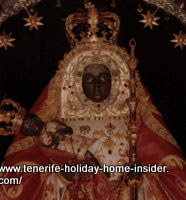
Encounter important cult relics of Aborigine Tenerife inhabitants in Candelaria, more of whom learn here. This town remains the Canary Islands' Mecca of worship of the Black Madonna as mother of Christ. There, famous caves had been harboring the black virgin of the Guanches, until washed out to sea. Replicas were made, of course. Discover more about the Canary archipelago patron...
It would make much sense that Tenerife's cavemen associated Chaxiraxi the ancient symbol of good harvests which also was a
fertility symbol for men and beast with the later discovered black Madonna. In fact, women had more prestige in the society of Tenerife's mountain and cave dwellers, as is
very typical for Neolithic people. This is contrary to the Spanish culture of the Middle Ages.
Guïmar and the altar of the sun.
Guïmar's pyramids were always in honor of the sun. while the main icon of Candelaria remained the Madonna with the dark complexion.
Beware of cave danger...
In the early XX, a small groups of tourists perished because of a natural lethal gas in one of Tenerife's caves. Not all caves were Guanche. The fatal cave was an ancient water mine. Unknown caves on any Canary Island should never be explored by amateurs.
More cave geology must prevail.
Nevertheless, few of Tenerife's cavernous hollow rocks have been marked. Many were even destroyed by road construction, as happened by 'Icod de los Trigos'. Cave explorations may not only give more geological clues but, may uncover more secrets about the origin of a small Macaronesian people which lived once like in stone age.
There is one stone inscription of a certified Berber sign of North Africa. It is from Tenerife finds. It suggests that there may have been some writing by Achinech cavemen of Tenerife or by people older than them. Several other symbols and signs which look like familiar letters are displayed on a white document in the stone's context at the famous Museum of Man and Nature of Tenerife. But, those scribbled writings look rather like a study result than like an archeology find. More archaeological research and more cave and soil excavations are absolutely required.
Chenech's tribes lived partly like in stone age, mummified their aristocrats, worshipped the sun on pyramids in G&ualt;ímar, celebrated the Solstice, had an accurate calendar, could read the stars and knew medicinal herbs.
Timber in Guanche folk art and crafts
The Chenech peoples had woodwork to an extent. Admire this elegant timber folk art on your right. They made lovely wooden Guanche dish bowls which didn't last well over the centuries, unfortunately. They also fabricated tools and weapons which were assembled by wood and stone but, had no bow and arrow, while no Tenerife plants would have been poisonous enough for the bows. Venomous snakes were not native to to their land, either. They also didn't make furniture. Also, it is believed that they didn't even attempt to build wooden canoes. This is very strange, as one can even look from some Canary Islands to the next when no clouds block. Perhaps, the Guanches had not found a way to fight woodworm. It is so widely spread on the Canary Islands and none of their timbers is hard enough to resist. The resin from the dragon tree may not have lasted in salt water. Timber pest control would have been important for furniture as well, on a rather large scale. Anyway, they were people who were content with what they had which must have been more of a mass philosophy than an attitude.
The main God and cults of the Guanches
The cavemen of Achinech had one main god called Achanán. They also had priestesses, nuns, a health care system with products from their soil and plants and they had a unique distance language which is still used in Tenerife's La Gomera and el Hierro. However, La Gomera's natives were not called Guanches. The Gan of Chinech had a sociopolitical system which worked, while no death penalty existed. They only fell into extreme, political disunity, after the baptizing of their last nine kings when Los Realejos made Castile or call it Spanish history of Guanches.
De Lugo's controversial ways of behavior
Of course, the conqueror Adelantado de Lugo knew how to play other cards with relentless hands. Intrigue and encouraged treason were other strategies used by him to crush a people's spirit when they opposed him in Guanche circles. Others, even Aborigins from abroad as well as Guanche allies were rewarded for helping him to gain victory in battle.
Now, continuing to explore an ancient culture such as that of Chinech can only enrich Tenerife history as brushed up diligently and chronologically here as well as its ethnology and anthropology. However, do not expect an Eldorado of gold and precious jewels inside Tenerife caves, ever...
From Guanche back to Los Realejos with links to intriguing folklore of Neolithic origin. .
Please mind that the comment box below is meant to help others. In case you have a question or want to tell me something, kindly use this contact form.
This site is protected by Copyscape Want to learn more about the period of cave dwellers?

Transfer wanted
in Europe?

Optica Columbus Best optician Tenerife North Important eye tests Call 922 387072
Insider

Note:
Text and images within this site are not to be copied or traded at any time. This regards online and offline.
Please respect my copyright
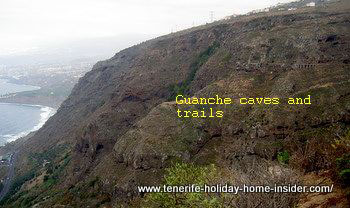

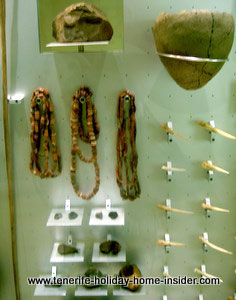
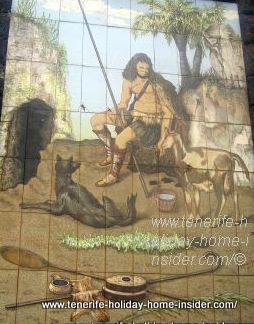
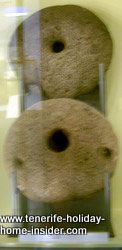
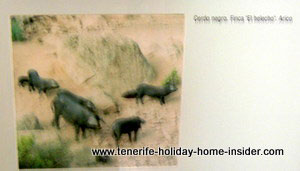
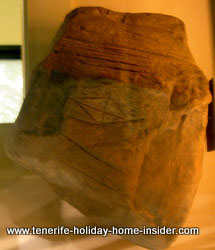
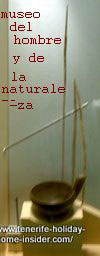







New! Comments
Have your say about what you just read! Leave me a new comment in the box below.